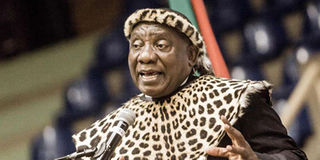Why Ramaphosa will find it difficult to end land injustices in South Africa

South African President Cyril Ramaphosa addresses the gathering during a hand over of 4,586 hectares of land to the community of KwaMkwanazi in Empangeni on October 14, 2018. He is initiating land reforms. PHOTO | RAJESH JANTILAL | AFP
What you need to know:
- There have been calls in Namibia echoing those in South Africa wanting a more radical approach to redistribution of land and wealth.
- Untangling the complex web of how modern economies work while moving meaningfully ahead with land restitution is the classic “Gordian knot” problem.
Post-independence land restitution is a problem many African countries face.
In South Africa, the Jacob Zuma-era governing African National Congress party took a decision to expropriate land without compensation.
It turns out, however, that much of the problem lies with the government itself, with plenty of land on offer on the “willing seller-willing buyer” basis.
There is plenty more that needs no buying as it is in the hands of the government.
The measure has huge appeal and is being touted by populists as the solution to the land problem.
Even President Cyril Ramaphosa admits that land hunger in rural areas is secondary to land hunger in towns.
INEQUALITY
Apartheid routinely pushed non-white South Africans to the fringes of cities and towns.
This means the poor have the longest commutes, the least access to public transport, suffer highest travel costs and the most distant access to high-density job centres.
The problem will not be solved by wishful thinking or meaningless reference to “radical economic transformation”, the latter turning out to be propaganda by the pro-Zuma faction in the ANC under which looting of State’s assets was meant to continue.
Twenty-years after independence, wealth in Namibia is still skewed along racial lines.
According to the World Bank, this country’s level of economic inequality is one of the highest on the planet, though it does not rise to the levels of South Africa’s.
In both, land distribution plays a big part in maintaining the socio-economic structure.
REFORMS
As a consequence, Namibia this month held its Second National Land Summit to discuss reforms.
Despite this, there are dissenting voices on how to address new and old inequalities. There have been calls in Namibia echoing those in South Africa wanting a more radical approach to redistribution of land and wealth.
In Namibia, 48 percent of land is privately owned, 35per cent is communal and the remaining is State land.
Seven out of 10 Namibians make their living from communal land, but fewer than 5,000 people — out of a population of 2.5 million — own freehold farmland.
This pattern reflects what neo-Marxists describe as “class inequality”.
However, the issue is racial rather than class, something Marx and similar thinkers had no meaningful handle on.
RESTITUTION
If race is the issue, why are two overtly non-racial democracies having so much trouble with the problem?
The embedded inequalities have become structural and intrinsic to the operation of these two States’ economies.
Failure to take this simple fact into account led to the insanity of Robert Mugabe’s Zimbabwe.
There is no question that in each case, the inequalities were and are a consequence of land dispossession during the colonial and apartheid or apartheid-style eras.
Untangling the complex web of how modern economies work while moving meaningfully ahead with land restitution is the classic “Gordian knot” problem.
Since independence, Namibia’s land reform has focused on two ways.
One is the National Resettlement Programme - which allows the government to buy freehold land to settle the landless. It follows the “willing seller-willing buyer” principle, as in South Africa.
RACE
The other has been through the Affirmative Action Loan Scheme, which allows “formerly disadvantaged” people to get subsidised loans to buy land.
There is a general feeling that neither approach is effective and so calls are mounting for the reform plan to be reviewed.
About 70 percent of the freehold agricultural land is still owned by “white” people.
As in South Africa, those advances made have tended to flow to a new elite, almost exclusively “black”, usually to people with close ties to government and international investors.
And, as with SA, it is the most disadvantaged – today, as well as historically – who tend not to receive significant, if any, benefits.
It is all very well for academics, usually of a neo-Marxist orientation, and political formations on the far left, to call for “radical” solutions, but such calls are meaningless in the absence of a workable plan.
Ramaphosa says that is what his administration will do.
If so, it will offer a resolution not only to South Africans desperate to own land for a farm or a home, but also to their long-suffering north-western neighbours in Namibia.





